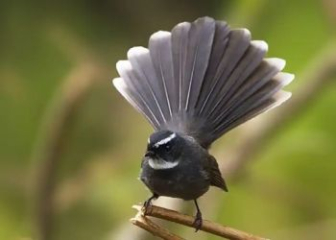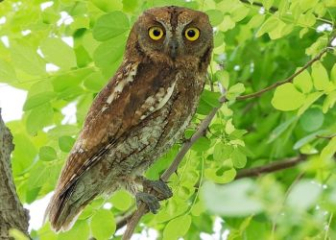Green Pheasant - Techniques for raising green pheasants at home from A to Z
Blog | by
The green pheasant is a rare ornamental bird, considered the "national bird" of Japan. It has an eye-catching appearance with iridescent blue feathers and a graceful appearance.
The green pheasant (scientific name Phasianus versicolor) is a bird endemic to Japan but is commonly raised in many countries, including Vietnam. They not only have an impressive and beautiful appearance but also bring high economic value.
If you want to raise green pheasants as pets or for commercial purposes, understanding the habits, behavior and care techniques of this bird is very important. Let's find out the details through the article below of nicebirds !
Information about Green Pheasant :
|
Scientific name |
Phasianus versicolor |
|
Common name |
Green pheasant, green pheasant |
|
Set |
Galliformes - Chicken |
|
Surname |
Phasianidae - Pheasants |
|
Spend |
Phasianus - Pheasant |
|
Source |
Japan |
|
Size |
55 - 90 cm |
|
Lifespan |
10 - 15 years, depending on care conditions |
Origin and distribution of Green Pheasant
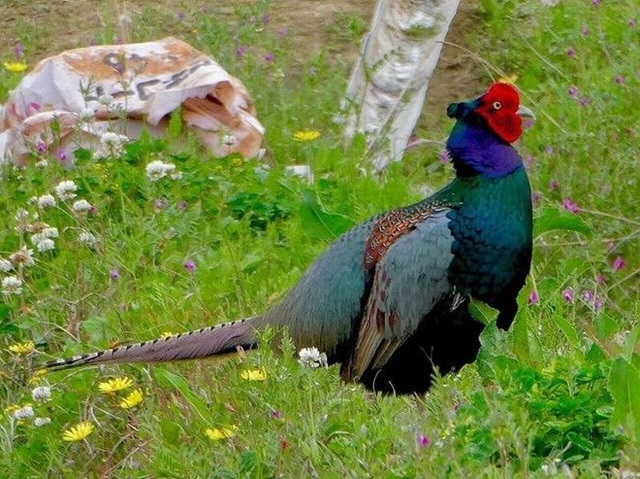
The blue pheasant is considered the national bird of Japan.
The green pheasant, also known as the green pheasant, has the scientific name Phasianus versicolor. They are a native bird endemic to Japan, often distributed on large islands such as Honshu, Kyushu or Shikoku. In Japan, the green pheasant is considered the "national bird" - a traditional cultural symbol with many spiritual and feng shui meanings of the country.
Thanks to their unique appearance, green pheasants have been introduced to several countries in Europe and Southeast Asia, including Vietnam. However, they are all artificially bred and crossbred over many generations, so they no longer retain the original beauty and high conservation value of purebred green pheasants.
Appearance of male and female green pheasants
Green pheasants are considered one of the most impressive and eye-catching ornamental birds in the Pheasant family. Let's find out in detail about the appearance of male green pheasants and female green pheasants to see if there are any differences!
Green Pheasant (Male)

Image of male green pheasant with colorful, eye-catching colors.
Male green pheasants are usually more splendid in appearance and larger in size than females, specifically as follows:
- Size : 75 - 90 cm (including tail)
- Weight : 900 - 1,200g
- Main fur color : Emerald green mixed with purple or blue when exposed to light, looks sparkling and eye-catching.
- Head and neck : Dark blue, or glossy black.
- Chest and back : Dark blue with purple hues.
- Face : There is a bright red area of bare skin surrounding the eyes that looks like a rooster's comb.
- Tail : Long, thin, slightly curved downwards, gray with black stripes, looks very special.
- Legs : Lead gray, adult birds have sharp spurs.
Green pheasant female

A female green pheasant with simple, rustic plumage.
The female green pheasant has a simple appearance and is smaller in size than the male, specifically as follows:
- Size : 55 - 65 cm (including tail)
- Weight : 100 - 850g
- Main feather color : Grayish brown combined with black spots, helps the bird camouflage well.
- Face, head and back : There are small, unevenly distributed stripes or spots.
- Tail : Shorter than male, no sheen.
Behavior of green pheasant
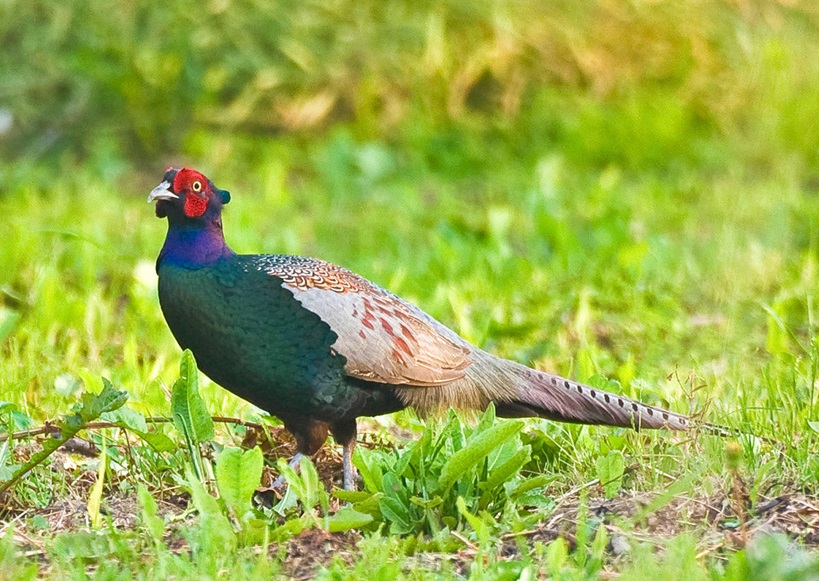
Green pheasant is walking on the ground foraging.
Right below are the typical habits and behaviors of green pheasants. Let's learn more to see if this bird has many interesting characteristics.
Habits
Green pheasants usually live in dense forests, bamboo forests, forest edges or grasslands with many bushes, fields or farms. They prefer terrain that is both open and has dense shelter so they can easily find food and hide.
Green pheasants are also often active in the early morning and late afternoon, when the weather becomes cool and pleasant. During the day, they will spend time hiding in the bushes.
Foraging behavior
Green pheasants are omnivorous birds with a varied diet, can eat seeds, berries, young shoots or insects, worms,...
They often use their feet to dig the ground or their beaks to search for food flexibly.
Social behavior
Green pheasants are highly territorial, especially males during breeding season. They will tend to chase away or use loud crowing to threaten other males if they invade their territory.
When the breeding season is over, green pheasants will often choose to live alone or gather in small groups, not liking to live in large flocks.
Defensive behavior
Green pheasants are quite shy, when threatened they often choose to run away into the bushes and only fly up when cornered. During the flight, they make strong wing flapping sounds, surprising the enemy and this is also considered an effective defense.
Reproductive behavior
Green pheasants usually breed from March to June. During this period, the male bird has many interesting behaviors to attract and court a mate. Specifically, the breeding process is as follows:
- The male bird will crow loudly with foot stamping, tail spreading, chest feathers ruffling, head raised or moving around the female bird to "show off".
- Female birds will often choose healthy, good-looking males to pair up and mate.
- They often nest on the ground, hidden in bushes and grass.
- Each clutch of female birds contains 6 - 12 eggs, then they incubate the eggs for 23 - 25 days.
- After hatching, the chicks will immediately follow the mother bird to forage. And during this process the male bird will not participate.
Effective green pheasant farming techniques
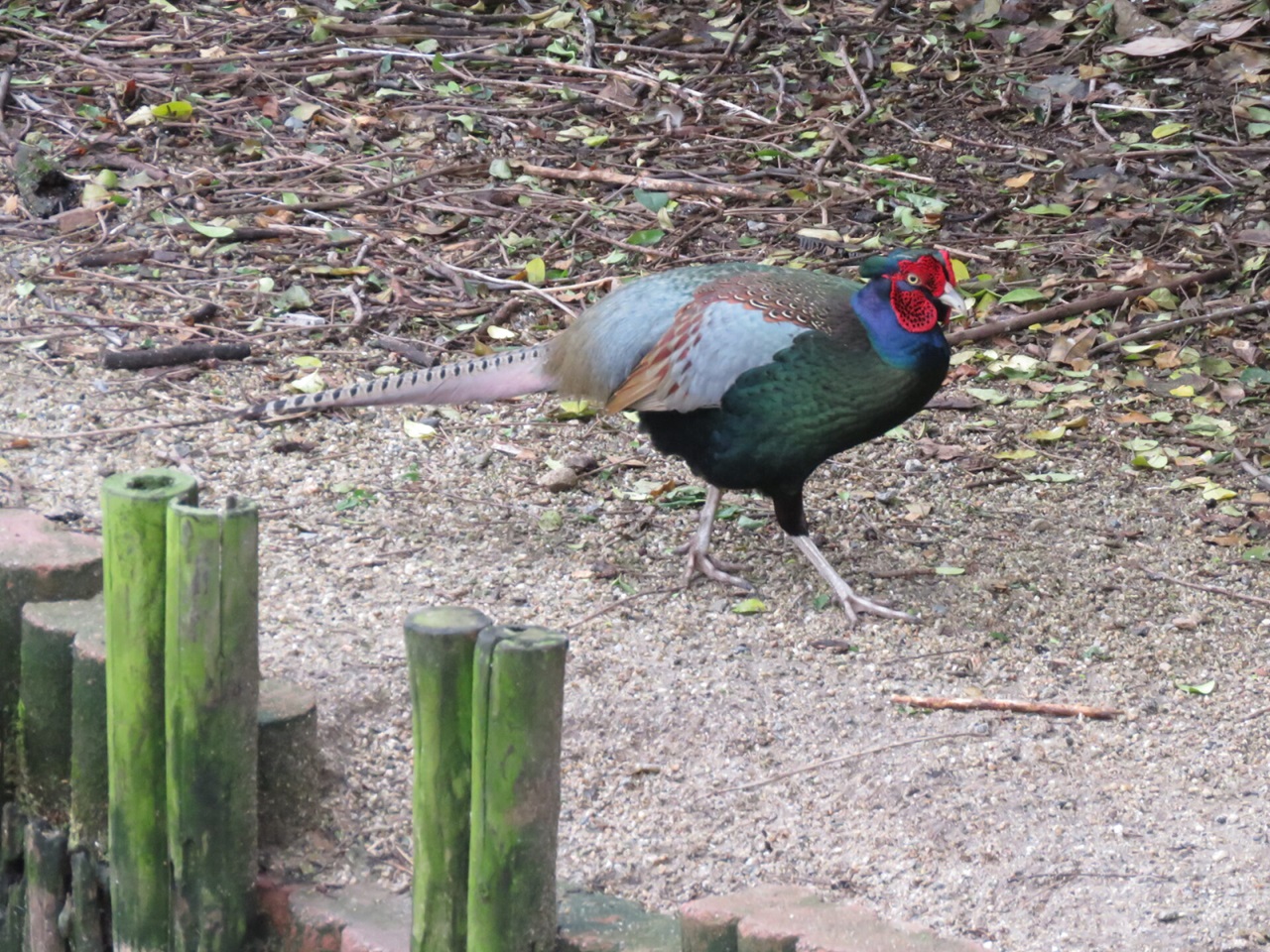
A green pheasant being raised in a semi-wild environment.
Currently, in addition to raising green pheasants as pets, many people also raise them for economic purposes. However, raising this bird successfully is not simple, so below we have shared detailed techniques for raising green pheasants effectively, let's find out now!
Prepare the barn
Because green pheasants are large and prefer a spacious, comfortable living environment, you need to design a suitable cage that meets the following criteria:
Location of the barn :
- Quiet, cool place, away from noise and dust.
- Surrounded by net to keep out dogs, cats, mice and even snakes
- Has good drainage system, dry.
Cage design :
- The area for a pair of green pheasants is at least 4 - 6 m2.
- The floor of the cage should be covered with a layer of sand, sawdust or rice husks.
- The cage needs to have a roof to cover the sun, the playground should have bushes and fake straw.
- Height from 2 - 3 m so that birds cannot jump out.
- Use stainless steel mesh or wire mesh around the cage.
- The roof of the cage should be covered with a soft mesh to limit injury when the bird hits its head.
Select green pheasant breed
If you want to be successful in raising green pheasants, you need to choose good breeding birds. A standard breeding bird usually includes the following elements:
- The bird is smart, has smooth feathers, is cool and bright, and has strong legs.
- The bird is not deformed.
- Clearly identify the male and female.
- You should buy baby birds that are over 1 month old and have been separated from their mother so that they are easier to care for and raise, and the price is also "softer".
Diet for green hemorrhoids
As shared above, green pheasants are omnivorous, they can eat many different types of food. However, a standard, nutritious diet for this bird will include the following:
- 70% pellets for chickens, quail or self-mixed.
- 30% is green vegetables, soft fruits and insects.
- Need to provide enough clean water.
Recommended serving size:
- Green pheasants under 1 month old: Eat industrial bran + crushed boiled eggs + digestive enzymes.
- Green pheasants 1 - 3 months old: Gradually increase the amount of pellets, add green vegetables and insects to increase protein.
- Adult green pheasants: Eat bran containing high protein content, supplement with rice, vegetables, and vitamins periodically.
You should supplement digestive enzymes, vitamin C, and electrolytes during rainy and hot seasons to increase the bird's resistance.
Green pheasant breeding techniques
If you want to successfully breed green pheasants, please note the following:
Reproductive pairing phase :
- Should raise in a ratio of 1 male and 2, 3 females to increase the possibility of pairing.
- Priority for breeding pairs is from March to June.
Egg collection and incubation phase :
- After the female bird lays eggs, collect the eggs every day and keep them in a cool, clean place.
- Use a specialized incubator to incubate eggs at a temperature of 36 - 38 degrees Celsius, 55 - 65% humidity.
- Incubation period is 23 - 25 days.
Baby bird raising stage :
- After the green pheasant chicks hatch, they need to be kept airtight and the heating lamp turned on at 30 - 33 degrees Celsius for the first week.
- Feed baby birds crushed boiled eggs, chick bran + digestive enzymes.
Disease prevention and health care for green hemorrhoids
Although green pheasants have good resistance, they are still susceptible to disease if the breeding conditions are not guaranteed. If you raise green pheasants as pets or for commercial purposes, please immediately apply some of the disease prevention and health care instructions below!
Basic principles of disease prevention :
- Keep the barn clean Clean food and water troughs every day, spray disinfectant and sterilize periodically 1-2 times/month.
- Provide a diet full of protein, minerals, and vitamins: Add digestive enzymes, vitamin C, electrolytes, or fresh garlic to increase resistance.
- Do not change food suddenly, but do it slowly so that the bird can get used to it gradually.
- Observe the bird every day. If you see any unusual signs such as not eating, eating less, standing in one place, ruffled feathers, wheezing, diarrhea, etc., you need to isolate the bird immediately for monitoring and timely treatment.
Common diseases of green hemorrhoids and treatment:
|
Disease name |
Symptom |
Prevention and treatment |
|
Newcastle disease (fowl cholera) |
Birds stop eating and have diarrhea. The bird tilted its head and ran in circles. |
Newcastle vaccine injection There is no specific treatment, only temporary symptomatic treatment. Sick birds should be isolated and destroyed to prevent spreading. |
|
Anthrax |
Bird has high fever and wheezing Bloody stools |
Pasteurellosis vaccine injection Use antibiotics combined with electrolytes and vitamin C |
|
Ecoli disease |
Birds have diarrhea, white or green stools, with an unpleasant fishy smell. Fluffy, lazy bird |
Ensure clean barns and avoid moisture. Add digestive enzymes to birds. Use Neomycin, Norfloxacin as directed. |
|
Coccidiosis |
Bloody stools Birds stop drinking and stop eating Bird died suddenly |
Use an anticoccidial such as Baycox at the recommended dose. |
Green pheasant price list
Currently in Vietnam, green pheasants are sold for many purposes such as keeping as pets, breeding or commercial farming. Therefore, there are many different prices, depending on age, gender, origin or selling area,... To learn more details, please refer to the following price list.
|
Green hemorrhoids (green hemorrhoids) |
Selling price (VND/piece) |
Note |
|
Newly hatched green pheasant |
100,000 - 150,000 |
Newly hatched birds from 1 - 7 days old, stable health |
|
Green pheasant |
150,000 - 250,000 |
Baby birds under 1 month old, healthy, eat and drink independently |
|
Adult male green pheasant |
800,000 - 1,500,000 |
Male bird over 5 months old, beautiful color |
|
Adult female green pheasant |
700,000 - 1,200,000 |
Has the ability to reproduce |
|
Green pheasant eggs |
30,000 - 50,000 VND/egg |
Fertilized eggs just need to hatch |
Note when buying green pheasant :
- Watch birds live to observe their appearance and health.
- If you buy bird eggs, you need to make sure that the fertilized egg rate is 80% or higher.
- Choose professional pheasant breeding farms for the best quality and price.
- If you buy online, you can refer to Cho Tot, Zalo OA farm to find shops with good reviews and quality.
- You can join groups such as "Pheasant Breeders Association", "7-Color Pheasant Association",... on Facebook to both buy and sell and exchange experiences.
Green pheasant image
Please admire the collection of green pheasant images below to fully appreciate the luxurious and noble beauty of this bird to see why they are so popular in the high-end bird world!
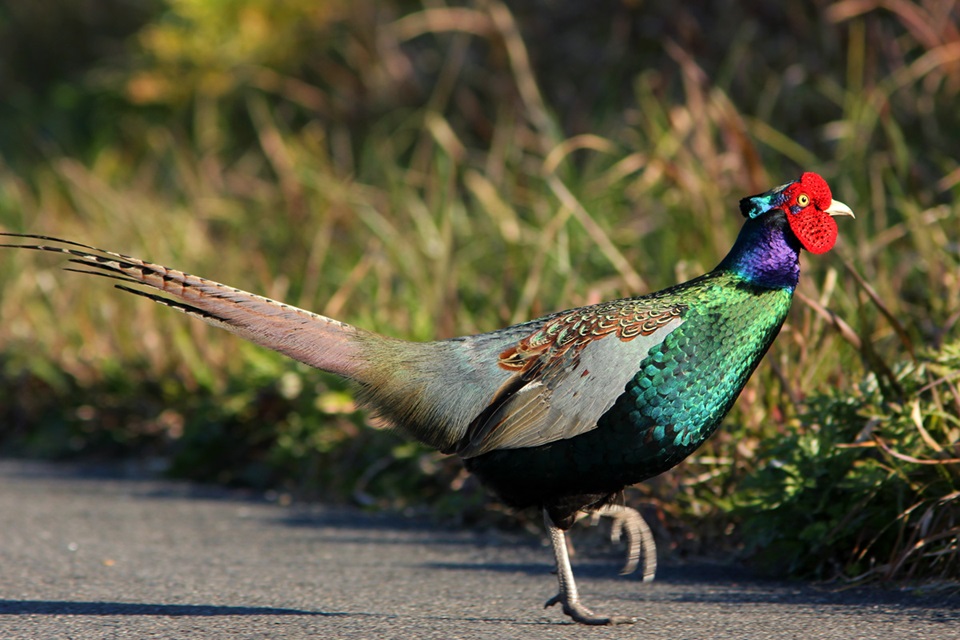
A male green pheasant with beautiful, iridescent plumage.

Image of green pheasant crowing loudly.

A green pheasant with brilliant plumage in the sunlight.
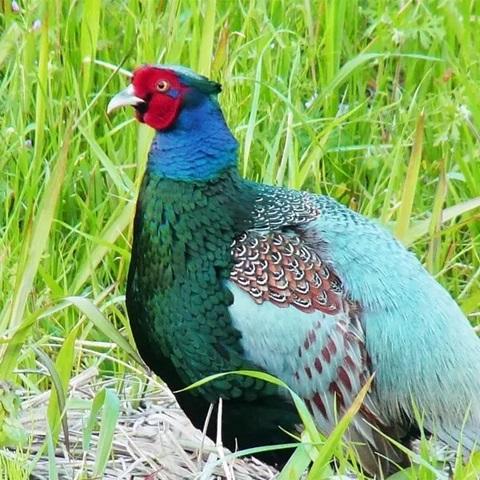
Close-up of the impressive feather colors and patterns of a male green pheasant.
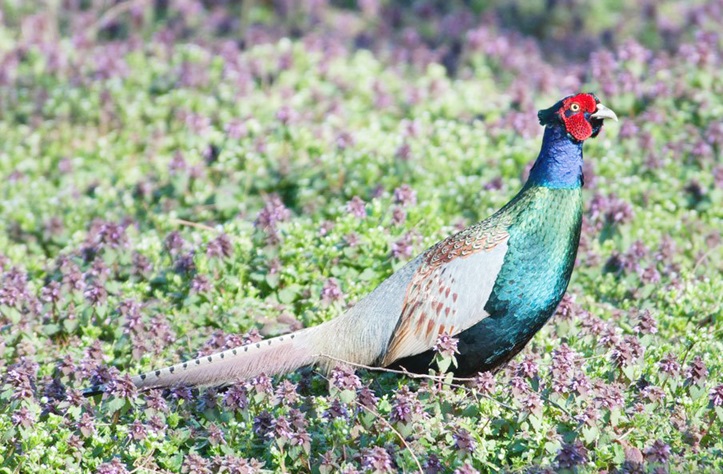
Image of green pheasant walking in the flower garden.
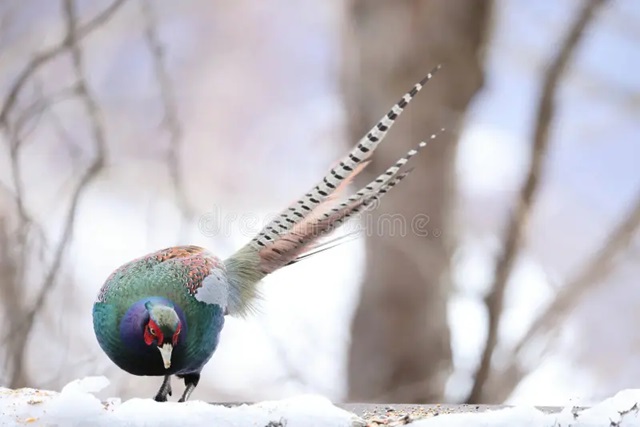
A green pheasant forages in the snow.
Male and female green pheasants are walking side by side.
Through the above article, nicebirds.net has shared details about green pheasants (green pheasants) , hoping that you have understood and gained more experience to be able to raise and care for this bird successfully. If invested properly, green pheasants are not only a unique ornamental bird but also an opportunity to "get rich" for the breeder.
Don't forget to visit our Blog section every day so you don't miss any interesting articles about other types of pet birds!

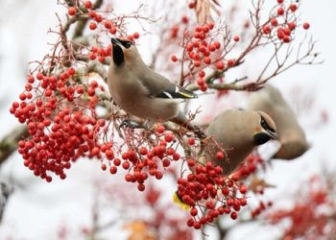

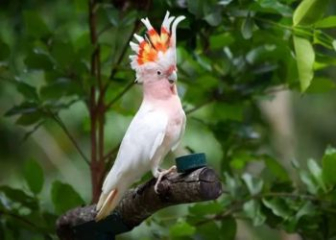
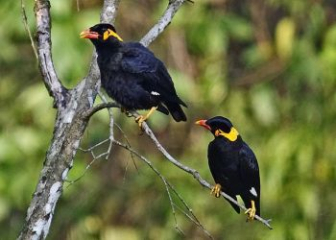
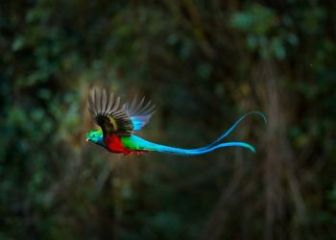





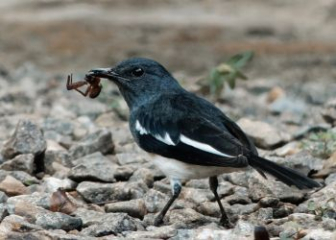
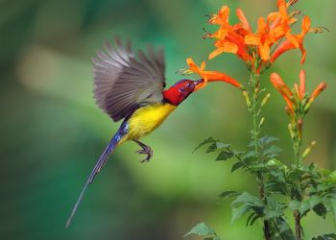


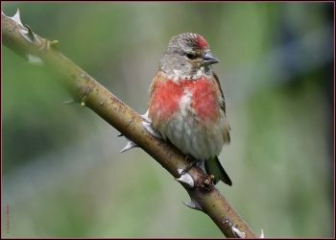
_350x250.jpg)
